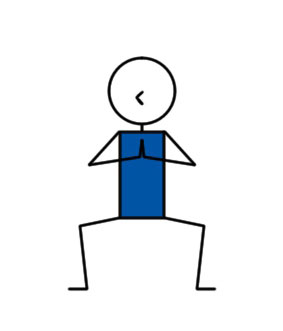Tips On Teaching Goddess Pose
Teach The Sanskrit Meaning
Utkata knoasana, means powerful angle, which describes the position of the legs and hips. It is a pose that strengthens the feminine and helps you connect to the hara, a space just beneath and behind your navel that is said to be your energetic centre (centre of your being).
Goddess Of Compassion Yoga Class Theme
If Goddess Pose is the peak pose for your class, invoke the power of Tara to your students, the Hindu Goddess Of Compassion. Focusing on "compassion" as a class theme will help your students be more at peace with themselves and others. For example, you could ask your students to practice self-compassion by becoming aware of their inner critic. For example you could ask your students to silently say, "I'm useless" and replace that inner sentence with, "You is good. You is kind. You is important" (which is a sentence a character says in a Hollywood film). Saying silently "you is" instead of "I am" add a bit of humour which is always good. The "You is good. You is kind. You is important" is my go to inner sentence whenever I become aware of being overly critical of myself.
The Arm Of Compassion: Teach Your Students How To Visualise Putting Themselves Literally In Someone Else's Shoes
We've all heard the saying: "Put yourself in their shoes". It's a great saying. And here's how to teach your students to apply the philosophy of that saying into their lives. Ask your students to find a partner. Place your partner's shoes on the front of your mat and sit facing the shoes. Close your eyes and see yourself wearing those shoes. Open your eyes and gaze at your partner for 30 seconds. Close your eyes and imagine you are your partner. Look down and see yourself in their shoes. As you let the inner scene play out, become aware of the compassion you feel for your partner now that you're in their shoes.
The Art Of Compassion: Teach How Turn Labels Into Imaginary Paper Planes That Fly Away
All experienced Yogis know the power of letting go. Instead of hanging onto dualistic judgments that label everything as “right” or “wrong,” “good” or “bad?” What if, instead, your students could just trust that life is a challenging game and everyone is doing the best to play it. Ask your students to impose a dualistic judgement on themselves (e.g. "I'm a bad person"). Ask them to imagine making a paper plane from that piece of A4 paper, like they did as a kid. See themselves whispering that judgement to the pilot, and then releasing the plane (and judgement). See it flying away. See it getting further and further away. Releasing judgment of others starts with letting go of self-judgments
The Art Of Compassion: Practice Presence
Ask your students to visualise being fully present with everyone they encounter. Ask them to close their eyes and see themselves with their phone in hand being approached by a friend. Ask them to see themselves putting their phone away, and engaging fully with their friend. Ask them to see themselves making eye contact with that friend. Ask them to notice the body language of that friend. When you are truly present, your presence will be experienced as compassion by those around you.
The Art Of Compassion: Openness Yoga Class Theme
Tell your students that Goddess Pose opens the hips, hamstrings, and heart. And when you physically open up, you also open up emotionally. When you open up emotionally, you become more compassionate and less judgemental. Judging is natural. It's an evolutionary adaption to judge (e.g. we have to judge if the sabre toothed tiger is going to attack). But it's not an evolutionary advantage to have a habit of judging yourself or others negatively.

